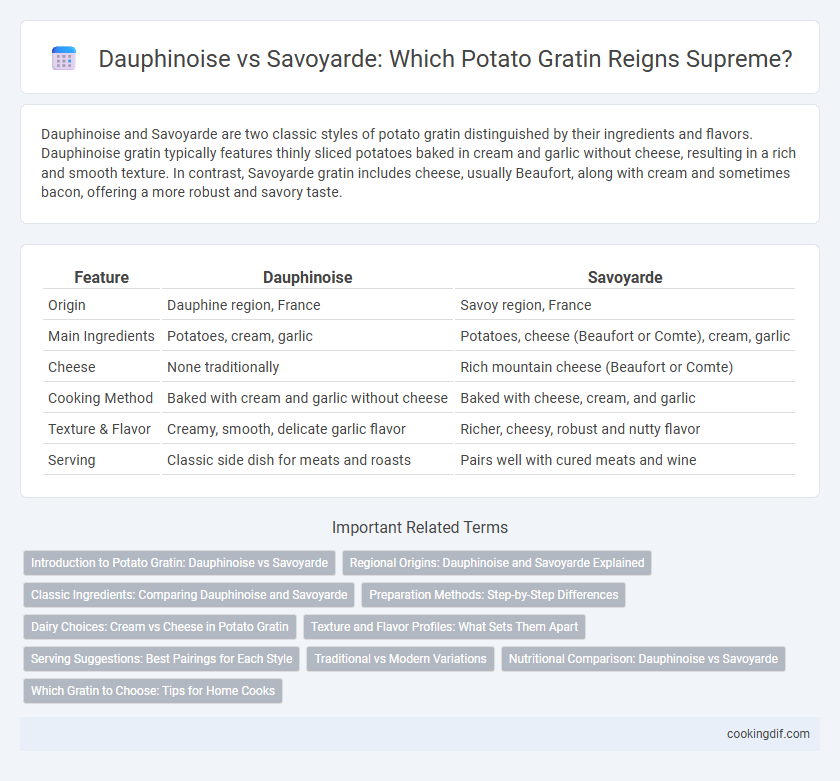Dauphinoise and Savoyarde are two classic styles of potato gratin distinguished by their ingredients and flavors. Dauphinoise gratin typically features thinly sliced potatoes baked in cream and garlic without cheese, resulting in a rich and smooth texture. In contrast, Savoyarde gratin includes cheese, usually Beaufort, along with cream and sometimes bacon, offering a more robust and savory taste.
Table of Comparison
| Feature | Dauphinoise | Savoyarde |
|---|---|---|
| Origin | Dauphine region, France | Savoy region, France |
| Main Ingredients | Potatoes, cream, garlic | Potatoes, cheese (Beaufort or Comte), cream, garlic |
| Cheese | None traditionally | Rich mountain cheese (Beaufort or Comte) |
| Cooking Method | Baked with cream and garlic without cheese | Baked with cheese, cream, and garlic |
| Texture & Flavor | Creamy, smooth, delicate garlic flavor | Richer, cheesy, robust and nutty flavor |
| Serving | Classic side dish for meats and roasts | Pairs well with cured meats and wine |
Introduction to Potato Gratin: Dauphinoise vs Savoyarde
Potato gratin features two classic French varieties: Dauphinoise and Savoyarde, each showcasing regional cheese and preparation techniques. Dauphinoise gratin uses thinly sliced potatoes baked in cream and garlic without cheese, creating a smooth, rich texture from the creamy base. In contrast, Savoyarde incorporates Emmental or Beaufort cheese and often includes butter and sometimes broth, adding a nutty, flavorful depth typical of the Alpine region.
Regional Origins: Dauphinoise and Savoyarde Explained
Dauphinoise potato gratin originates from the Dauphine region of southeastern France, traditionally made with thinly sliced potatoes baked in cream and garlic without cheese, highlighting the rich, velvety texture characteristic of alpine cuisine. Savoyarde potato gratin hails from the Savoie region and incorporates local ingredients such as Beaufort cheese, butter, and sometimes cured ham, reflecting the region's mountain culture and emphasis on robust, savory flavors. Understanding these regional origins showcases the distinct culinary identities and ingredient variations that define each gratin style.
Classic Ingredients: Comparing Dauphinoise and Savoyarde
Dauphinoise gratin features thinly sliced potatoes baked in cream and garlic, often without cheese, highlighting the richness of dairy. Savoyarde gratin incorporates potatoes layered with Beaufort cheese, butter, and occasionally white wine, delivering a more robust flavor profile. Both use potatoes as a base but differ significantly in dairy components and seasoning, defining their classic regional identities.
Preparation Methods: Step-by-Step Differences
Dauphinoise potatoes are thinly sliced and baked in cream with garlic, ensuring a smooth, custard-like texture, while Savoyarde involves layering potatoes with Beaufort cheese, butter, and sometimes cured ham for a richer, more textured gratin. The Dauphinoise preparation typically omits cheese, emphasizing slow cooking to meld cream and potatoes, whereas Savoyarde gratin requires precise layering and longer baking to melt the cheese and develop a golden crust. Temperature control and ingredient layering are crucial in Savoyarde to balance the creamy interior with the crispy top, differentiating it significantly from the uniformly creamy Dauphinoise.
Dairy Choices: Cream vs Cheese in Potato Gratin
Dauphinoise potato gratin traditionally relies on heavy cream to achieve its rich, silky texture, emphasizing a smooth, custard-like consistency without the sharpness of cheese. In contrast, Savoyarde gratin incorporates cheese such as Beaufort or Gruyere, which melts into the dish, creating a more robust and flavorful profile with a browned, crispy top. The choice between cream-heavy Dauphinoise and cheese-heavy Savoyarde defines the gratin's texture and taste, balancing creaminess against savory intensity.
Texture and Flavor Profiles: What Sets Them Apart
Dauphinoise gratin features thinly sliced potatoes baked in a creamy, garlic-infused bechamel sauce, resulting in a rich, silky texture with subtle earthy undertones. Savoyarde gratin incorporates melted cheese like Beaufort or Comte and cured ham, creating a heartier, more robust flavor with a slightly firmer, chewy texture. The Dauphinoise emphasizes smooth creaminess and delicate garlic notes, while the Savoyarde offers a savory, alpine depth and a more textured bite.
Serving Suggestions: Best Pairings for Each Style
Dauphinoise gratin, rich with cream and garlic, pairs exceptionally well with roasted meats such as beef or lamb and complements robust red wines like a Cotes du Rhone. Savoyarde gratin, featuring Gruyere cheese and often incorporating white wine, is ideal alongside cured meats or charcuterie boards and suits dry white wines from the Alpine region, like Apremont. Both styles enhance hearty stews or grilled vegetables, but their pairing reflects the distinct regional flavors and richness of each gratin.
Traditional vs Modern Variations
Dauphinoise potato gratin, a traditional French dish, features thinly sliced potatoes baked in cream and garlic without cheese, emphasizing simplicity and rich creaminess. Savoyarde represents a modern variation that incorporates cheese such as Beaufort or Gruyere, adding a savory depth and a golden crust. These variations illustrate the evolution from classic, creamy textures toward richer, cheese-infused profiles in potato gratins.
Nutritional Comparison: Dauphinoise vs Savoyarde
Dauphinoise potato gratin typically contains thinly sliced potatoes baked with cream, garlic, and cheese, resulting in a rich, high-calorie dish with significant fat content from heavy cream and cheese. Savoyarde gratin incorporates potatoes with Beaufort cheese, cured ham, and broth, offering higher protein levels and slightly less fat due to the use of leaner ingredients and broth instead of heavy cream. Both gratins provide substantial carbohydrates from potatoes but differ nutritionally, where Dauphinoise emphasizes cream-based richness and Savoyarde balances protein content with relatively lower fat.
Which Gratin to Choose: Tips for Home Cooks
Dauphinoise and Savoyarde potato gratins differ primarily in ingredients and texture, with Dauphinoise using cream and garlic for a rich, smooth finish, while Savoyarde features cheese, typically Beaufort, and sometimes includes ham or bacon for a heartier flavor. Home cooks should choose Dauphinoise for a classic, velvety dish perfect as a side, whereas Savoyarde suits those seeking a more robust, alpine-inspired gratin. Optimal preparation includes thinly slicing potatoes and baking at moderate temperatures to achieve a tender interior and golden crust.
Dauphinoise vs Savoyarde for potato gratin Infographic

 cookingdif.com
cookingdif.com